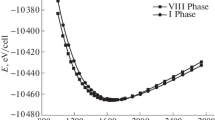Abstract
We study the structural phase transition, elastic and thermodynamic properties of HfCr2 from first-principles calculations. The simulated results are very close to those of previous studies. The phase transition from C15 to C36 occurs at about 202.7 GPa, while the phase transition pressure from C36 to C14 is about 283.9 GPa. It can be seen from the phonon spectra and elastic constants that HfCr2 is mechanically stable at C15 phase. It can be concluded that C15 phase HfCr2 is ductile from 0 to 200 GPa, and the bigger the pressure, the greater the ductility from G/B value and Poisson’s ratio. Then, through the analysis of density of states, the mechanism of metal properties is discussed. Finally, the relation of thermal expansion coefficient, Debye temperature and thermal capacity to pressure and temperature is discussed.
Graphical abstract

The structural phase transition and thermodynamic properties of HfCr2





Similar content being viewed by others
Data availability
This manuscript has associated data in a data repository. [Authors' comment: The datasets generated during and/or analyzed during the current study are available from the corresponding author on reasonable request.].
References
F. Cuevas, J.M. Joubert, M.A. Latroche, Intermetallic compounds as negative electrodes of Ni/MH batteries. Appl. Phys. A Mater. 722, 25–238 (2001)
D.G. Ivey, D.O. Northwood, Storing hydrogen in AB2 laves-type compounds. Z. Phys. Chem. 147, 91–209 (1986)
J.F. Fernández, J. Bodega, C.R. Sánchez, Hydriding/dehydriding properties ofmagnesium-ZrCr2 composites. J. Alloys Compd. 356–357, 343–347 (2003)
E. Rudy, The phase diagrams hafnium-vanvdium and hafnium-chromium. J. Less Common Met. 15, 13–27 (1968)
S. Hong, C.L. Fu, Theoretical study on cracking behavior in two-phase alloys Cr–Cr2X (X=Hf, Nb, Ta, Zr). Intermetallics 9, 799–805 (2001)
X.-Q. Chen, W. Wolf, R. Podloucky, P. Rog, Ab initio study of ground-state properties of the Laves phase compounds TiCr2, ZrCr2, and HfCr2. Phys. Rev. B 71, 174101 (2005)
F. Sun, J. Zhang, S. Mao, X. Han, First-principles studies of the structural and electronic properties of the C14 Laves phase XCr2 (X = Ti, Zr, Nb, Hf and Ta). Philos. Mag. 93, 2563–2575 (2013)
L. Liu, P. Shen, X. Wub, R. Wang, W. Li, Q. Liu, First-principles calculations on the stacking fault energy, surface energy and dislocation properties of NbCr2 and HfCr2. Comput. Mater. Sci. 140, 334–343 (2017)
J.P. Perdew, K. Burke, M. Ernzerhof, Generalized gradient approximation made simple. Phys. Rev. Lett. 77, 3865–3868 (1996)
J.P. Perdew, J.A. Chevary, S.H. Vosko, K.A. Jackson, M.R. Pederson, D.J. Singh, C. Fiolhais, Atoms, molecules, solids, and surfaces: applications of the generalizedgradient approximation for exchange and correlation. Phys. Rev. B. 46, 6671–6687 (1992)
H.J. Monkhorst, J.D. Pack, Special points for Brillouin-zone integrations. Phys. Rev. B 13, 5188–5192 (1976)
F.D. Murnaghan, The compressibility of media under extreme pressures. Proc. Natl. Acad. Sci. 30, 44–247 (1944)
S. Shang, Y. Wang, Z.-K. Liu, First-principles elastic constants of α- and β-Al2O3. Appl. Phys. Lett. 90, 101909 (2007)
G.S.H. Wang, Single Crystal Elastic Constants and Calculated Elastic Properties: A Handbook (M.I.T, Cambridge, 1971)
M. Born, On the stability of crystal lattices, I. Math. Proc. Camb. Philos. Soc. 36, 160–172 (1940)
R. Hill, The elastic properties of crystalline aggregate. Proc. Soc. 65, 349–354 (1952)
M.A. Blanco, E. Francisco, V. Luaña, GIBBS: isothermal-isobaric thermodynamics of solids from energy curves using a quasi-harmonic Debye model. Comput. Phys. Commun. 158, 57–72 (2004)
A.J. Rutgers, J. Vidts, Supersonic vibration potentials (Debye effect) in colloidal solutions. Nature 165, 109 (1950)
A. Bouhemadou, R. Khenata, Pseudo-potential calculations of structural and elastic properties of spinel oxides ZnX2O4(X = Al; Ga; In) under pressure effect. Phys. Lett. A. 360, 339–343 (2006)
L. Louail, D. Maouche, A. Roumili, F.A. Sahraoui, Calculation of elastic constants of 4d transition metals. Mater. Lett. 58, 2975–2978 (2004)
D. Santamarıa-Perez, R.S. Kumar, A.J. Dos Santos-Garcıa, High-pressure transition to the post-barite phase in BaCrO4 hashemite. Phys. Rev. B 86, 094116 (2012)
S.F. Pugh, XCII, Relations between the elastic moduli and the plastic properties of polycrystalline pure metals. Lond. Edinb. Dublin Philos. Mag. J. Sci. 45, 823–843 (2009)
J. Hoeksema, Pseudogapping: its syntactic analysis and cumulative effects on its acceptability. Res. Lang. Comput. 4, 335–352 (2006)
Funding
This research did not receive any specific grant from funding agencies in the public, commercial, or not-for-profit sectors.
Author information
Authors and Affiliations
Contributions
H-JB obtained the data and wrote the paper. X-RQ drew the data graph and revised the paper.
Corresponding author
Ethics declarations
Conflict of interest
The authors declared that there is no conflict of interest.
Rights and permissions
Springer Nature or its licensor (e.g. a society or other partner) holds exclusive rights to this article under a publishing agreement with the author(s) or other rightsholder(s); author self-archiving of the accepted manuscript version of this article is solely governed by the terms of such publishing agreement and applicable law.
About this article
Cite this article
Bai, HJ., Qin, XR. First-principles study of the structural phase transition, elastic and thermodynamic properties of HfCr2. Eur. Phys. J. B 96, 61 (2023). https://doi.org/10.1140/epjb/s10051-023-00525-y
Received:
Accepted:
Published:
DOI: https://doi.org/10.1140/epjb/s10051-023-00525-y




